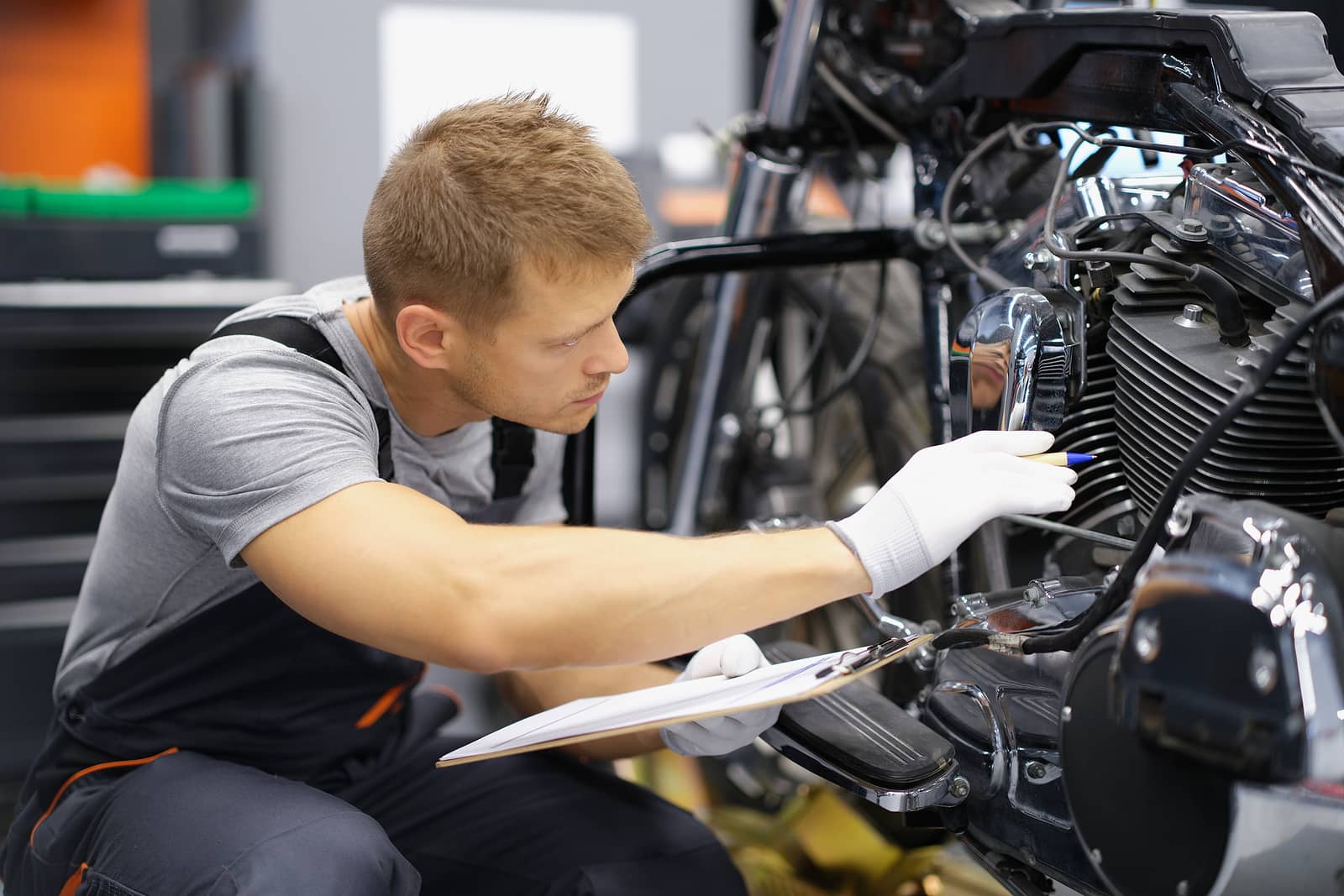UPDATED: APRIL 27, 2023 | 3 MIN READ

Spring is a great time to take your motorcycle out for a spin. But before you head out, ensuring your bike is safe and ready for the season is important. This motorcycle inspection checklist helps you identify potential issues so you can address them before they become more serious.
Motorcycle Inspection Checklist

Carry Out a Visual Check
Walk around your bike and give it a once-over to check for damage. Make sure all parts are intact, including mirrors and levers.
Although it may not seem like a big deal, damage to any motorcycle part can lead to safety issues. All parts should be checked for damage before riding. Remember, your motorcycle insurance policy might help cover the costs if your bike is damaged.
Check the Fluid Levels
Motorcycle fluids are normally grouped into engine oil and other fluids. The engine oil is checked by checking the level on the dipstick or using a dipstick tester.
The other fluids are checked using a sight glass located outside most motorcycles or by opening up a petcock valve to check fuel levels.
Replace the Fuel Filter
Replacing the fuel filter is an important and often overlooked step in motorcycle maintenance step. The fuel filter removes dirt, rust, and other gas particles before reaching your engine. This can help you avoid clogging up hoses and damaging your bike.
Check the Chain
Check the tension on your chain and sprockets. It should be tight enough, so it doesn’t slack when you try to move it with one hand, but not so tight that it’s hard to move with two hands.
Lubricate all of the moving parts on your bike, including the chain and sprockets. This reduces friction, which makes it easier for your engine to turn over.
Test the Lights
Driving with inoperable headlights or taillights is a common traffic violation. It’s important to check your lights because you may not notice they’re out until you get pulled over. Also, if your lights don’t work, it’s difficult to see at night or in the rain.
Check Cable Health
Over time, motorcycle cables can deteriorate due to weather exposure and use. This can lead to leaks and other problems. Inspect all the cables on your motorcycle for any signs of deterioration or damage.
Test the Brakes
The least convenient time to figure out that your breaks don’t work properly is when you need them.
It is important to check brakes periodically for proper operation, squeaks, and grinding. If the brakes are making noise when applied, it’s time to get replacements installed.
Inspect the Tires
Tires are an essential part of your motorcycle’s suspension system. They help you maintain traction and control on road surfaces.
Ensure your tires are in good condition and have no leaks, cracks, or bulges. Check that there are no nails, stones, or other debris in the treads and sufficient air pressure in each tire.
Check their tread depth as well. If it’s below 4/32”, replace your tires.
Test the Battery
The battery is one of the most important components of your motorcycle. It provides power to the motor and makes it run. Inspect the battery for corrosion or leaks before you charge it.
If your motorcycle battery is not charging, check that the positive and negative terminals make good contact. If you find any corrosion or damage, clean it up with a stiff brush before charging.
Refuel
Make sure the tank is full before you start your first ride. Then, during your trip, keep an eye on your fuel gauge to ensure it doesn’t get too low.
Review Your Insurance
Make sure your motorcycle insurance is up to date before your first ride. Also, if you’ve made any modifications to your bike, double-check that your policy covers them. Don’t forget to shop around either. You might be surprised at how easy it is to find cheap motorcycle insurance.
Motorcycle Inspection FAQs
What should I check on a motorcycle?
It’s important to inspect the outside of your bike for damage. Also, check your battery, tires, fluid, and fuel levels before your first ride of the year.
How long should I warm up my bike before riding?
Run your bike for a few minutes before setting off. This is to ensure that the bike fluids have time to warm up and circulate throughout the bike.
Should you start your motorcycle every day?
Motorcycles are designed to be started and ridden intermittently. However, it’s not necessary to start your motorcycle every day.
Do fuel-injected motorcycles need to warm up?
Typically, it’s a good idea to warm up all types of motorcycles. Let it run for a few minutes before you take off.
Is it bad to ride a motorcycle in the cold?
It’s not bad for motorcycles to be ridden in cold weather, but it does require more care and preparation than riding during warmer months. Make adjustments to your outfit and bike to ensure safety.
Motorcycle Inspection Checklist: The Bottom Line
Before you head out on the road for the first time this year, doing a pre-ride inspection is important. In addition to checking your bike for damage and doing the usual inspections, take some time to ensure your insurance is up to date. Get several motorcycle insurance quotes to get the best possible coverage and rates.